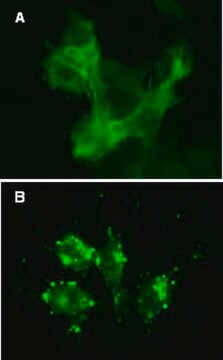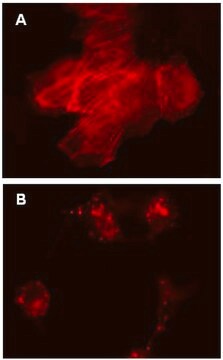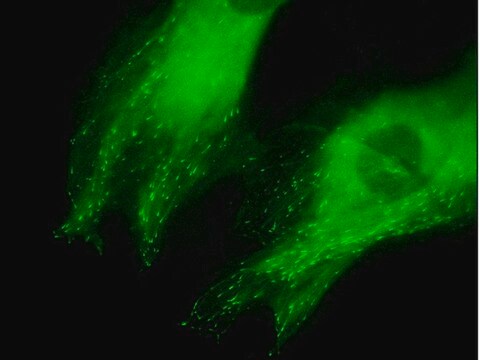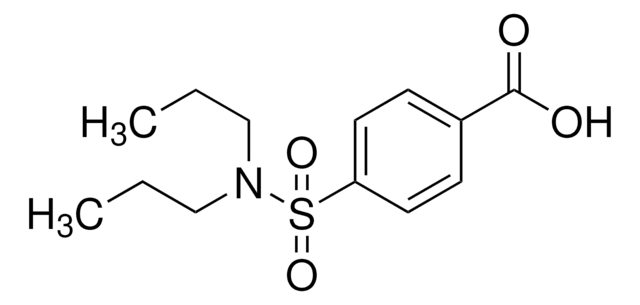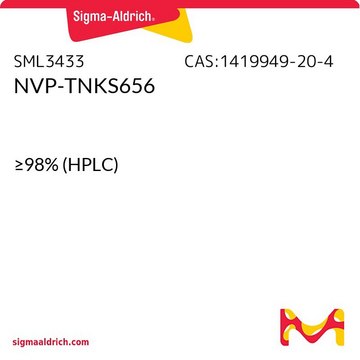17-10220
LentiBrite RFP-Rad51 Lentiviral Biosensor
Anmeldenzur Ansicht organisationsspezifischer und vertraglich vereinbarter Preise
Alle Fotos(5)
About This Item
UNSPSC-Code:
12352207
eCl@ss:
34360190
NACRES:
NA.52
Empfohlene Produkte
Allgemeine Beschreibung
Read our application note in Nature Methods!
http://www.nature.com/app_notes/nmeth/2012/121007/pdf/an8620.pdf
(Click Here!)
Learn more about the advantages of our LentiBrite Lentiviral Biosensors! Click Here
Biosensors can be used to detect the presence/absence of a particular protein as well as the subcellular location of that protein within the live state of a cell. Fluorescent tags are often desired as a means to visualize the protein of interest within a cell by either fluorescent microscopy or time-lapse video capture. Visualizing live cells without disruption allows researchers to observe cellular conditions in real time.
Lentiviral vector systems are a popular research tool used to introduce gene products into cells. Lentiviral transfection has advantages over non-viral methods such as chemical-based transfection including higher-efficiency transfection of dividing and non-dividing cells, long-term stable expression of the transgene, and low immunogenicity.
EMD Millipore is introducing LentiBrite Lentiviral Biosensors, a new suite of pre-packaged lentiviral particles encoding important and foundational proteins of autophagy, apoptosis, and cell structure for visualization under different cell/disease states in live cell and in vitro analysis.
EMD Millipore’s LentiBrite RFP-Rad51 lentiviral particles provide bright fluorescence and precise localization to enable live cell analysis of Rad51 translocation in difficult-to-transfect cell types.
http://www.nature.com/app_notes/nmeth/2012/121007/pdf/an8620.pdf
(Click Here!)
Learn more about the advantages of our LentiBrite Lentiviral Biosensors! Click Here
Biosensors can be used to detect the presence/absence of a particular protein as well as the subcellular location of that protein within the live state of a cell. Fluorescent tags are often desired as a means to visualize the protein of interest within a cell by either fluorescent microscopy or time-lapse video capture. Visualizing live cells without disruption allows researchers to observe cellular conditions in real time.
Lentiviral vector systems are a popular research tool used to introduce gene products into cells. Lentiviral transfection has advantages over non-viral methods such as chemical-based transfection including higher-efficiency transfection of dividing and non-dividing cells, long-term stable expression of the transgene, and low immunogenicity.
EMD Millipore is introducing LentiBrite Lentiviral Biosensors, a new suite of pre-packaged lentiviral particles encoding important and foundational proteins of autophagy, apoptosis, and cell structure for visualization under different cell/disease states in live cell and in vitro analysis.
- Pre-packaged, fluorescently-tagged with GFP & RFP
- Higher efficiency transfection as compared to traditional chemical-based and other non-viral-based transfection methods
- Ability to transfect dividing, non-dividing, and difficult-to-transfect cell types, such as primary cells or stem cells
- Non-disruptive towards cellular function
EMD Millipore’s LentiBrite RFP-Rad51 lentiviral particles provide bright fluorescence and precise localization to enable live cell analysis of Rad51 translocation in difficult-to-transfect cell types.
Rad51, a eukaryotic RecA-like recombinase, plays a key role in homologous recombination occurring in both the normal cell cycle and repair of DNA damage. However, excess cellular Rad51, as occurs in many cancers, leads to resistance to DNA-damaging radiation and chemotherapy, and genomic instability. Upon DNA damage generating double strand breaks, Rad51 coalesces from the nucleoplasm to discrete nuclear foci, but such foci also occur in the absence of DNA damage when Rad51 is overexpressed. Expression of Rad51 fused to GFP has been employed to trace the dynamics of Rad51 compartmentalization in live cells.
EMD Millipore’s LentiBrite RFP-Rad51 lentiviral particles provide bright fluorescence and precise localization to enable live cell analysis of Rad51 translocation in difficult-to-transfect cell types.
EMD Millipore’s LentiBrite RFP-Rad51 lentiviral particles provide bright fluorescence and precise localization to enable live cell analysis of Rad51 translocation in difficult-to-transfect cell types.
Anwendung
Research Category
Apoptose & Krebs
Apoptose & Krebs
Research Sub Category
Zellzyklus, DNA-Replikation & -Reparatur
Zellzyklus, DNA-Replikation & -Reparatur
Fluorescence Microscopy Imaging:
HeLa cells were plated in a chamber slide and transduced with lentiviral particles at an MOI of 20 for 24 hours. After media replacement and 48 hours further incubation, cells were fixed with formaldehyde and mounted. Images were obtained by oil immersion wide-field fluorescence microscopy. The RFP-Rad51 displays a variably punctate distribution in the nucleus.
Immunocytochemistry Comparison:
U2OS cells were plated in a chamber slide and transduced with lentiviral particles at an MOI of 5 for 24 hours. After 24 hours, media was replaced and cells were then further incubated for 48 hours. Immunocytochemical staining (green) with a polyclonal antibody against Rad51 (Cat No. ABE257) reveals a similar expression pattern to RFP-Rad51 (red).
Hard-to-transfect Cell Types:
Primary cell types HUVEC or HuMSC were plated in chamber slides and transduced with RFP-Rad51 lentiviral particles at an MOI of 20 and 5, respectively, for 24 hours.
Confocal Microscopy Imaging:
U2OS cells were transduced with RFP-Rad51 lentivirus. Cells were counterstained with FITC-phalloidin to show the actin filaments (green) and DAPI to show the nucleus (blue). Images were obtained by oil immersion confocal fluorescence microscopy.
Additional Cell Type:
HT1080 cells were treated.
For optimal fluorescent visualization, it is recommended to analyze the target expression level within 24-48 hrs after transfection/infection for optimal live cell analysis, as fluorescent intensity may dim over time, especially in difficult-to-transfect cell lines. Infected cells may be frozen down after successful transfection/infection and thawed in culture to retain positive fluorescent expression beyond 24-48 hrs. Length and intensity of fluorescent expression varies between cell lines. Higher MOIs may be required for difficult-to-transfect cell lines.
HeLa cells were plated in a chamber slide and transduced with lentiviral particles at an MOI of 20 for 24 hours. After media replacement and 48 hours further incubation, cells were fixed with formaldehyde and mounted. Images were obtained by oil immersion wide-field fluorescence microscopy. The RFP-Rad51 displays a variably punctate distribution in the nucleus.
Immunocytochemistry Comparison:
U2OS cells were plated in a chamber slide and transduced with lentiviral particles at an MOI of 5 for 24 hours. After 24 hours, media was replaced and cells were then further incubated for 48 hours. Immunocytochemical staining (green) with a polyclonal antibody against Rad51 (Cat No. ABE257) reveals a similar expression pattern to RFP-Rad51 (red).
Hard-to-transfect Cell Types:
Primary cell types HUVEC or HuMSC were plated in chamber slides and transduced with RFP-Rad51 lentiviral particles at an MOI of 20 and 5, respectively, for 24 hours.
Confocal Microscopy Imaging:
U2OS cells were transduced with RFP-Rad51 lentivirus. Cells were counterstained with FITC-phalloidin to show the actin filaments (green) and DAPI to show the nucleus (blue). Images were obtained by oil immersion confocal fluorescence microscopy.
Additional Cell Type:
HT1080 cells were treated.
For optimal fluorescent visualization, it is recommended to analyze the target expression level within 24-48 hrs after transfection/infection for optimal live cell analysis, as fluorescent intensity may dim over time, especially in difficult-to-transfect cell lines. Infected cells may be frozen down after successful transfection/infection and thawed in culture to retain positive fluorescent expression beyond 24-48 hrs. Length and intensity of fluorescent expression varies between cell lines. Higher MOIs may be required for difficult-to-transfect cell lines.
Komponenten
TagRFP-Rad51 Lentivirus:
One vial containing 25 µL of lentiviral particles at a minimum of 3 x 10E8 infectious units (IFU) per mL. For lot-specific titer information, please see “Viral Titer” in the datasheet.
Promoter
EF-1 (Elongation Factor-1)
Multiplicty of Infection (MOI)
MOI = Ratio of # of infectious lentiviral particles (IFU) to # of cells being infected.
Typical MOI values for high transduction efficiency and signal intensity are in the range of 20-40. For this target, some cell types may require lower MOIs (e.g., HT-1080, HeLa, U2OS, human mesenchymal stem cells (HuMSC)), while others may require higher MOIs (e.g., human umbilical vein endothelial cells (HUVEC)).
NOTE: MOI should be titrated and optimized by the end user for each cell type and lentiviral target to achieve desired transduction efficiency and signal intensity.
One vial containing 25 µL of lentiviral particles at a minimum of 3 x 10E8 infectious units (IFU) per mL. For lot-specific titer information, please see “Viral Titer” in the datasheet.
Promoter
EF-1 (Elongation Factor-1)
Multiplicty of Infection (MOI)
MOI = Ratio of # of infectious lentiviral particles (IFU) to # of cells being infected.
Typical MOI values for high transduction efficiency and signal intensity are in the range of 20-40. For this target, some cell types may require lower MOIs (e.g., HT-1080, HeLa, U2OS, human mesenchymal stem cells (HuMSC)), while others may require higher MOIs (e.g., human umbilical vein endothelial cells (HUVEC)).
NOTE: MOI should be titrated and optimized by the end user for each cell type and lentiviral target to achieve desired transduction efficiency and signal intensity.
Qualität
Evaluated by transduction of HT-1080 cells and fluorescent imaging performed for assessment of transduction efficiency.
Physikalische Form
PEG precipitation
Lagerung und Haltbarkeit
Storage and Handling
Lentivirus is stable for at least 4 months from date of receipt when stored at -80°C. After first thaw, place immediately on ice and freeze in working aliquots at -80°C. Frozen aliquots may be stored for at least 2 months. Further freeze/thaws may result in decreased virus titer and transduction efficiency.
IMPORTANT SAFETY NOTE
Replication-defective lentiviral vectors, such as the 3rd Generation vector provided in this product, are not known to cause any diseases in humans or animals. However, lentiviruses can integrate into the host cell genome and thus pose some risk of insertional mutagenesis. Material is a Risk Group 2 and should be handled under BSL2 controls. A detailed discussion of biosafety of lentiviral vectors is provided in Pauwels, K. et al. (2009). State-of-the-art lentiviral vectors for research use: Risk assessment and biosafety recommendations. Curr. Gene Ther. 9: 459-474.
Lentivirus is stable for at least 4 months from date of receipt when stored at -80°C. After first thaw, place immediately on ice and freeze in working aliquots at -80°C. Frozen aliquots may be stored for at least 2 months. Further freeze/thaws may result in decreased virus titer and transduction efficiency.
IMPORTANT SAFETY NOTE
Replication-defective lentiviral vectors, such as the 3rd Generation vector provided in this product, are not known to cause any diseases in humans or animals. However, lentiviruses can integrate into the host cell genome and thus pose some risk of insertional mutagenesis. Material is a Risk Group 2 and should be handled under BSL2 controls. A detailed discussion of biosafety of lentiviral vectors is provided in Pauwels, K. et al. (2009). State-of-the-art lentiviral vectors for research use: Risk assessment and biosafety recommendations. Curr. Gene Ther. 9: 459-474.
Rechtliche Hinweise
CHEMICON is a registered trademark of Merck KGaA, Darmstadt, Germany
Lagerklassenschlüssel
10 - Combustible liquids
WGK
WGK 2
Analysenzertifikate (COA)
Suchen Sie nach Analysenzertifikate (COA), indem Sie die Lot-/Chargennummer des Produkts eingeben. Lot- und Chargennummern sind auf dem Produktetikett hinter den Wörtern ‘Lot’ oder ‘Batch’ (Lot oder Charge) zu finden.
Besitzen Sie dieses Produkt bereits?
In der Dokumentenbibliothek finden Sie die Dokumentation zu den Produkten, die Sie kürzlich erworben haben.
Verwandter Inhalt
Fluorescent lentiviral particles encoding important GFP/RFP fusion proteins related to autophagy, apoptosis, and cell structure that enables live cell imaging.
Unser Team von Wissenschaftlern verfügt über Erfahrung in allen Forschungsbereichen einschließlich Life Science, Materialwissenschaften, chemischer Synthese, Chromatographie, Analytik und vielen mehr..
Setzen Sie sich mit dem technischen Dienst in Verbindung.
